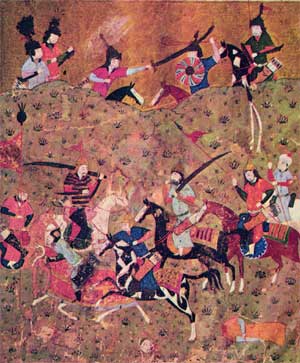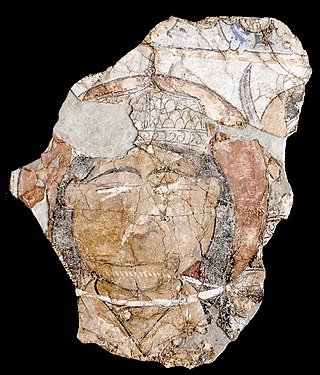
The Kara-Khanid Khanate, also known as the Karakhanids, Qarakhanids, Ilek Khanids or the Afrasiabids, was a Turkic khanate that ruled Central Asia in the 9th through the early 13th century. The dynastic names of Karakhanids and Ilek Khanids refer to royal titles with Kara Khagan being the most important Turkic title up until the end of the dynasty.

Jalāl al-Dawla Mu'izz al-Dunyā Wa'l-Din Abu'l-Fatḥ ibn Alp Arslān, better known by his regnal name of Malik-Shah I, was the third sultan of the Great Seljuk Empire from 1072 to 1092, under whom the sultanate reached its zenith of power and influence.
Abūʾl-Faḍl Muḥammad ibn Ḥusayn Bayhaqī, better known as Abu'l-Faḍl Bayhaqi, was a Persian secretary, historian and author.

The Anushtegin dynasty or Anushteginids, also known as the Khwarazmian dynasty was a Persianate Sunni Muslim dynasty of Turkic mamluk origin from the Bekdili clan of the Oghuz Turks. The Anushteginid dynasty ruled the Khwarazmian Empire, consisting in large parts of present-day Central Asia, Afghanistan and Iran in the approximate period of 1077 to 1231, first as vassals of the Seljuks and the Qara Khitai, and later as independent rulers, up until the Mongol conquest of the Khwarazmian Empire in the 13th century.

The Samanid Empire also known as the Samanian Empire, Samanid dynasty, Samanid amirate, or simply as the Samanids) was a Persianate Sunni Muslim empire, of Iranian dehqan origin. The empire was centred in Khorasan and Transoxiana; at its greatest extent encompassing Persia and Central Asia, from 819 to 999.

The Battle of Dandanaqan was fought in 1040 between the Seljuq Turkmens and the Ghaznavid Empire near the city of Merv. The battle ended with a decisive Seljuq victory, which subsequently brought down the Ghaznavid domination in Greater Khorasan.

Shahāb-ud-Dawla Mawdūd, known as Mawdud of Ghazni, was a sultan of the Ghaznavids from 1041 – 1050. He seized the throne of the sultanate from his uncle, Muhammad of Ghazni, in revenge for the murder of his father, Mas'ud I of Ghazni. His brother Majdud in Lahore did not recognize him as sultan, but his sudden death paved the way for Mawdud to exercise control over the eastern portion of the Ghaznavid Empire.

Il-Arslan was the Shah of Khwarezm from 1156 until 1172. He was the son of Atsïz.
Altuntash was a Turkic Khwarazmshah from 1017 until his death in 1032.
The Al-i Muhtaj or Muhtajids was an Iranian or Iranicized Arab ruling family of the small principality of Chaghaniyan. They ruled during the 10th and early 11th centuries.

Chaghaniyan, known as al-Saghaniyan in Arabic sources, was a medieval region and principality located on the right bank of the Oxus River, to the south of Samarkand.
The Farighunids were an Iranian dynasty that ruled Guzgan in the late 9th, 10th and early 11th centuries. They were ultimately deposed by the ruler of the Ghaznavid Empire, Sultan Mahmud.

Masʽud I of Ghazni, known as Amīr-i Shahīd, was sultan of the Ghaznavid Empire from 1030 to 1040. He rose to power by seizing the Ghaznavid throne from his younger twin Mohammad, who had been nominated as the heir upon the death of their father Mahmud of Ghazni. His twin was shortly blinded and imprisoned. However, when much of Masʽud's western domains had been wrested from his control, his troops rebelled against him and reinstated Mohammad to the throne.

The Battle of Qatwan was fought in September 1141 between the Qara Khitai and the Seljuq Empire and its vassal-state the Kara-Khanid Khanate. The Seljuqs were decisively defeated, which signalled the beginning of the end of the Great Seljuk Empire.

Ali ibn Hasan, also known as Harun Bughra Khan and better known as Ali-Tegin was a Karakhanid ruler in Transoxiana from 1020 to 1034 with a brief interruption in 1024/5.
Böritigin, also known as Ibrahim ibn Nasr or Tamghach Khan Ibrahim, was a Karakhanid ruler in Transoxiana from 1038 to 1068. He was one of the greatest rulers of the dynasty.
Arslan Isra'il, also known as Arslan Yabgu was a Turkic chieftain, who was from the Kınık tribe, which would later establish the Seljuk Empire. His name Arslan means "the lion". Arslan was son of the warlord Seljuk and uncle to the founders of the Seljuk empire, Chaghri and Tughril.
The Battle of Dabusiyya was fought between the Ghaznavid Empire and the Kara-Khanid Khanate in April 1032 near Dabusiyya, a small town between Bukhara and Samarkand. The result was a bloody stalemate which left the commander of the Ghaznavid forces, Altun Tash, mortally wounded.
Shams al-Mulk Nasr was a Karakhanid ruler in Transoxiana from 1068 to 1080. He was one of the greatest rulers of the dynasty.

Uthman ibn Ibrahim was a Karakhanid ruler in Transoxiana from 1204 to 1212.











